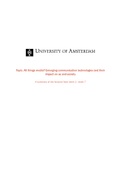Topic: All things media? Emerging communication technologies and their
impact on us and society
A summary of the lectures from week 1 - week 7
,Lecture 1: Background, context, concepts: introduction
Mass communication:
● Public
● Technologically mediated
● Indirect (face-to-face, what we do during class, is direct)
● One-sided (sender and a receiver)
● Dispersed audience (all viewers/readers are dispersed, not in one room)
Face-to-face communication: the ‘richest type of communication’
● Intentionally/awareness of all involved persons
● Mutual co-orientation
● Direct
● Negotiation of meaning (encoding and decoding) → communication is all about meaning
● Exchange of communicator and receiver role, reciprocity
● Process (dynamic, changing)
● Common code, signs, symbols, and rules of communication (like letting someone who is
talking finish and other rules)
● Multifunctional (different functions, e.g., small talk)
● Multimodal (voice, non-verbal)
Computer-mediated communication:
● “Human communication…
● …achieved through, or with the help of,
● …computer technology.”
Dimensions of computer-mediated communication:
1. Mode (text, audio, visual)
2. Synchronous (in real time, facetime) vs. Asynchronous (like newspaper)
3. Public vs. Non-public
4. Dyadic (one-on-one) vs. Group
5. Anonymous vs. Nonymous (are you identifiable or prefer not to?)
6. Professional/Work-related vs. Private
Technology: “A manner of accomplishing a task especially using technical processes, methods, or
knowledge.”
Emerging technologies:
1. Radical novelty
2. Relatively fast growth (from telephone to smartphone)
3. Coherence (different names and terms, in the end ‘social media’)
4. Potential to have prominent impact on socio-economic domains
5. Uncertainty and ambiguity in the emergence phase (so many platforms with good ideas that
didn’t make it)
Crucial technological changes:
1. Exponential increases in computing power (our phones become old very quickly, they can’t take
what we do with it anymore)
2. Mobile connectivity (we are always connected, we can do things when we’re not on location)
1
, 3. Datafication; networked information (all that we do can be datafied)
4. Miniaturisation of sensors, microphones, and cameras
5. Cloud computing (no longer on your harddrive, also on the cloud)
6. Progress in artificial intelligence, machine learning
The hype circle of emerging technologies:
- In the beginning certain things were all hyped up, but afterwards you can see problems, not
living up to expectations
- It’s a very complex thing, otherwise we would more easily be able to predict what would be a
hit and what not
Characteristics of innovation:
1. Relative advantage (innovation does something better than it’s previous version)
2. Compatibility (it needs to be linkable to something that was there before)
3. Complexity, or ease to learn to use (if it’s too complex, people won’t use it)
4. Trialability (people want to try it)
5. Observability (how do other people experience it)
Typology:
1. Innovators (2.5%) → people who line up to get the first iPad
2. Early adopters (13.5%)
3. Early majority (34%)
4. Late majority (34%) → might not need it or don’t have the financial possibility earlier on
5. Laggards (16%) → might be forced, because there is no other way to live life anymore (like
not being able to pay in cash anymore)
Affordances of digital information (1s and 0s):
1. Storability (our head normally lets go of information at some point, but technology gives us a
way of storing a lot of information. Doing it digitally you won’t lose it that fast)
2. Replicability (can be copied easily)
3. Searchability/retrievability (Ctrl+F)
4. Distributability (from letters to mail, also called scalability)
Affordances of digital information are at the heart of digital development.
2





